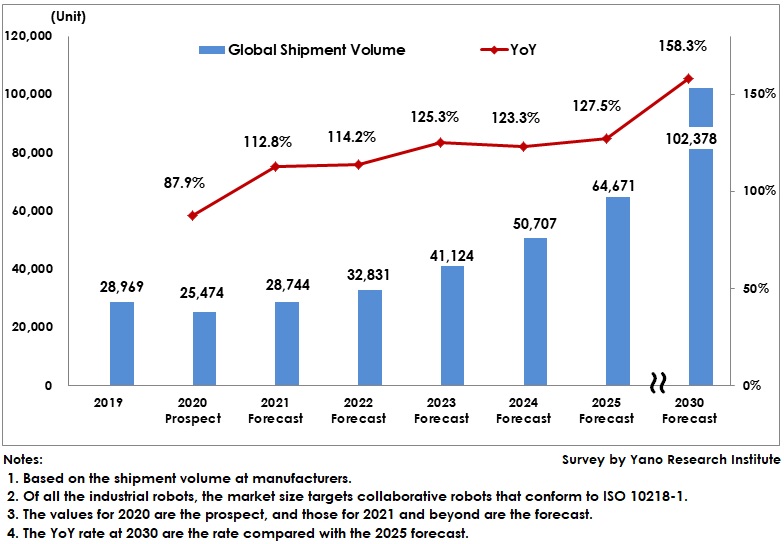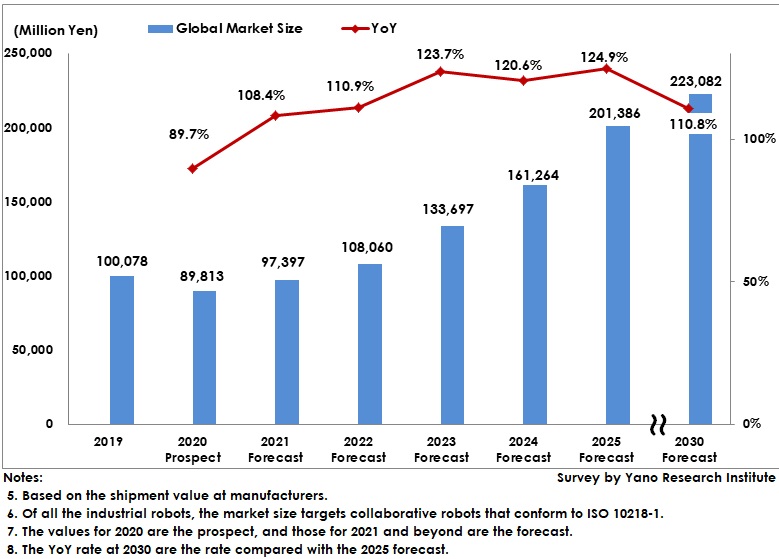No.2648
Global Collaborative Robot (Cobot) Market: Key Research Findings 2020
Global Cobot Shipment Volume to Reach 102,378 Units and Shipment Value to Attain 223,082 Million Yen by 2030
Yano Research Institute (the President, Takashi Mizukoshi) carried out a survey on the global market of collaborative robots (cobots) and found out the related policies and support systems at major companies, the trend of market players, and the future perspectives.


Market Overview
The global collaborative robot (hereafter “cobot”) market size in 2019 was estimated as 28,969 units by shipment volume at manufacturers, or 100,078 million yen by shipment value. In the fourth industrial revolution, flexible manufacturing (availability to manufacture a variety of products in small lots) is needed for responding to the demand by user companies. Because cobots are easier than existing industrial robots to install and operate, and simple to rearrange and change the existing layouts and processes, they have been increasingly installed in the production processes difficult to place industrial robots.
While industrial robots handle heavy objects that no humans can lift up or perform coating and welding difficult for humans, cobots contribute in more precise works like screw fastening and power-controlled polishing of curved surfaces, which can be done in the same workspace as the humans without any safety fences. Therefore, industrial robots and cobots play mutually complementary roles to comprise a smart factory and are indispensable in automated production. However, because of stagnant production at the manufacturing industry caused by lingering trade frictions between the U.S. and China, and of deteriorated working rate for production due to COVID-19 pandemic, the global cobot market size in 2020 is expected to decline to 25,474 units, 87.9% on YoY by shipment volume, and to 89,813 million yen, 89.7% on YoY by shipment value.
Noteworthy Topics
New Applications to Services and Other Industries
When observing the shipment volume of cobots by industry, the ratio utilized in the service and other industries is forecasted to increase from 23.2% in 2020 to 38.1% by 2030.
China, where adoption of cobots more advanced than other countries in the world, use cobots for unprecedented categories that have never imagined before, such as for massage physiotherapy or maintenance work of high voltage cables at a power grid system. As a government-led project in South Korea, cobots are used at handmade shoe workshop and for food services such as at fried chicken store, coffee shop, and beer specialty store. In Japan, cobots have been progressively adopted in robot introduction feasibility study aiming at utilizing robots in food, medical and cosmetic industries as well as service industry.
Future Outlook
After the latter half of 2021, as COVID-19 pandemic is subdued and when the economy and capital investment at the manufacturing industry recover, the global cobot market size is expected to reach 102,378 units by shipment volume and 223,082 million yen by shipment value by 2030.
As new technologies including IoT, AI, and 5G are to be embedded in cobots furthermore for the future, the application areas of cobots are likely to expand further. In addition, increase in number of companies entering the market to manufacture cobots, cost reduction for parts is expected, reducing the cobot price by around 30% of that of 2020 by 2030.
Research Outline
2.Research Object: Major manufacturers of cooperative robots in Japan and overseas
3.Research Methogology: Face-to-face interviews by the expert researchers, and literature research
What are Collaborative Robots?
Collaborative robots or cobots are one of industrial robots that are designed to directly work with humans within a prescribed workspace. They are the industrial robots installed in the same working space as humans and can work collaboratively with humans.
Cobots in this research refer to manipulating industrial robots that include vertical articulated robots and horizontal articulated robots, meaning that those machinery that have three or more of axes, move by automatic control, have reprogrammable multi-purpose manipulation functions, and conform to the international standard ISO 10218-1.
<Products and Services in the Market>
Industrial robots, collaborative robots, cobots, vertical articulated robots, horizontal articulated robots, robot system integration
Published Report
Contact Us
The copyright and all other rights pertaining to this report belong to Yano Research Institute.
Please contact our PR team when quoting the report contents for the purpose other than media coverage.
Depending on the purpose of using our report, we may ask you to present your sentences for confirmation beforehand.